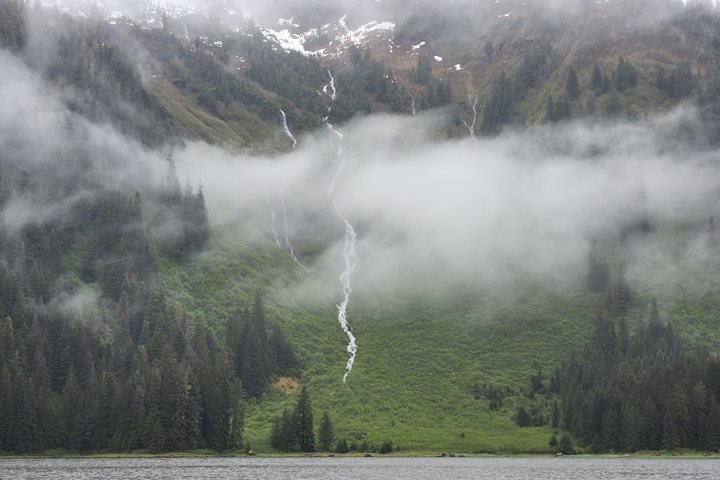During the night the National Geographic Sea Bird traveled south through Chatham Strait to reach the southern tip of Admiralty Island, then eastward and south again through Frederick Sound. The mainland of Alaska and, just beyond the peaks that were visible, Canada lay to the east, Kupreanof Island to the west. Our morning destination was a boardwalk trail that begins at Ideal Cove and takes us through a magnificent stand of old growth coastal spruce-hemlock forest. Old growth represents the final stage for forest development, where the forest has reached a steady state of species composition. The old growth temperate rain forest has a continuous ground cover of mosses, ferns, and low-growing flowering plants. Above this is a shrub layer, then tree saplings striving to reach the light above, and finally, high above us, the forest canopy. The trees of this forest reach well over 100 feet in height. Light penetrates through openings in the canopy to fuel the productivity of the forest. When a canopy trees dies and falls, it creates a light gap in the forest, and the fallen giant is quickly colonized by mosses. It becomes a nurse log on which the next generation of forest trees will germinate and begin growth. The old growth forest is a dynamic entity. It is also provides the highest volume of potential lumber, and therein lies the conflict over management of the Tongass National Forest: should the most magnificent forest stands be cut for their timber or preserved for their innate and scenic value? It is important for us to remember that the Tongass is a National Forest, belonging to all of us, and we are free to enter the debate. Anyway ... it was a most enjoyable walk through the forest, leg-stretching for some, more quiet and contemplative for others.
We returned to our vessel and retraced our wake back to Petersburg. As we moved, Max Seigal gave a presentation on commercial fishing in Alaska. The Tongass National Forest is a major spawning area for Alaska's five species of salmon, and the waterways support an abundance of halibut, sablefish, crabs, and other species that, collectively, support a very productive fishery. Petersburg is a real Alaskan fishing community; no T-shirt shops and jewelry emporia here. Directly or indirectly, the town is supported by the productivity of the sea. Here, we offered a diversity of activities; so hard to choose! There were bicycles for a self-guided tour; walks on the dock with Max and Carlos; hikes through the forest to a muskeg bog with Berit and Steve; a photo walk with Justin; or just the opportunity to stroll, perhaps to explore a local bookstore or Alaska's finest hardware shop, which stocks everything that is needed to keep the fishing fleet in operation.
Back to the ship, and our departure from Petersburg was followed by a tasting of the local fare: a feast of fresh Petersburg Dungeness crab. Shell fragments were flying.







